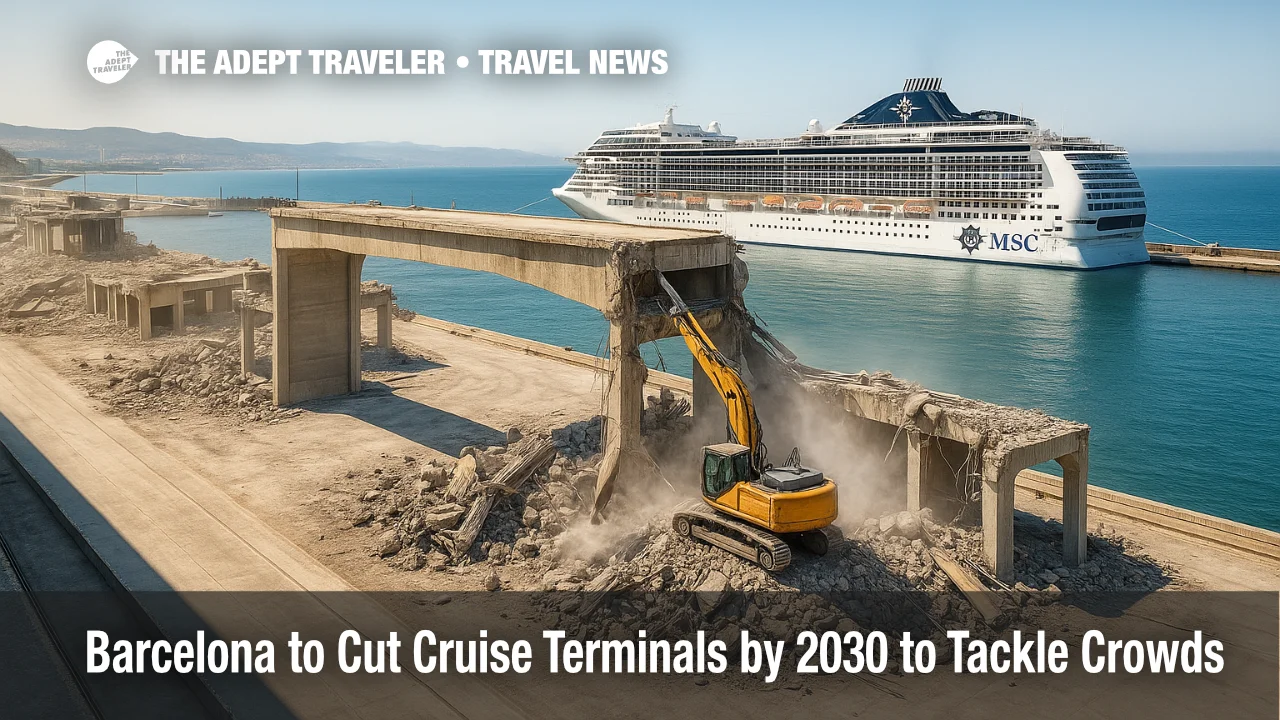Barcelona to Cut Cruise Terminals by 2030 to Tackle Crowds

Barcelona will demolish three cruise terminals at Moll Adossat and replace them with one larger, shore-powered facility, reducing the port's cruise terminals from seven to five by 2030. The plan caps simultaneous passenger throughput at 31,000-about 16 percent below today's limit-and prioritizes vessels that start and end voyages in the city to entice longer stays and bigger local spending. City Hall says the move is the first formal ceiling on cruise growth, part of a wider push to curb overtourism and slash ship-borne emissions. Construction begins next year under a €185 million ($202 million) budget, with completion set for late 2029.
Key Points
- Capacity cut: 37,000 ➜ 31,000 passengers per day
- Three older terminals will be razed; one new public terminal will serve up to 7,000 passengers
- Shore-power ready, meeting EU 2030 on-dock electrification mandate
- Home-port calls favored; quick "panoramic" stops discouraged
- Why it matters: Barcelona ranks No. 1 in Europe for cruise calls, fueling crowding at La Sagrada Familia and other landmarks
Snapshot
Barcelona's City Council and the Port of Barcelona signed a binding protocol on July 17, 2025, to consolidate cruise operations at the far end of Moll Adossat. Terminals A, B, and C will be demolished in 2026, clearing space for a single, 495,000-square-foot, all-electric terminal due online in 2029. The surviving facilities-D, E, F, and the World Trade Center pier-will receive minor upgrades but no capacity boosts. Upon completion, the port will handle a maximum of 31,000 cruise passengers at any one time, down from 37,000 today. Real-time crowd dashboards, added shuttles, and new bike lanes aim to disperse travelers and cut bus traffic.
Background
Cruise arrivals in Barcelona jumped 20 percent from 2018 to 2024, then accelerated another 20 percent in the first five months of 2025, hitting 1.2 million travelers. Local residents have staged regular demonstrations-most recently playful water-gun "degrowth" protests-to highlight rising rents and congested streets. City Hall first limited cruise docking at inner-harbor wharfs in 2018, pushing traffic to Moll Adossat on the port's seaward edge. The new protocol tightens the screws by eliminating three berths outright. It also dovetails with Barcelona's 2029 ban on new short-term rentals and the 2028 freeze on additional hotel licenses, creating a multi-pronged strategy to balance visitor spending with resident quality of life.
Latest Developments
Barcelona's plan does more than knock down buildings; it rewires how the Mediterranean's busiest cruise hub will function over the next decade.
Terminal Consolidation
Demolition of Terminals A, B, and C begins in spring 2026, after the winter cruise lull. Crews will build a single public terminal on the footprint of Terminal C, designed to process up to 7,000 passengers per turn. The structure will feature dual gangways, automated baggage scanners, and rooftop solar panels feeding into the shore-power grid.
Home-Port Strategy
The port will prioritize vessels that begin and end itineraries in Barcelona, rather than short "panoramic" stopovers. Officials argue that turn-around guests typically book hotels, dine ashore, and spend 2.3 times more than day-trippers. Advance slot allocation software, due in 2027, will assign berths to maximize overnight stays while keeping daily headcounts within the 31,000-passenger cap.
Emissions and Electrification
All five remaining terminals-plus the new build-will connect ships to 11-kilovolt shore-power stations by 2028, beating the EU's 2030 deadline. The port estimates that plugging vessels into the local grid could cut dockside nitrogen-oxide and particulate emissions by 38 percent. A parallel €50 million mobility hub, replacing Terminals A and B, will house electric shuttle buses, bike rentals, and real-time crowd monitors feeding citywide tourist-flow dashboards.
Beyond bricks and cables, the protocol obliges cruise lines to stagger disembarkation times, reducing morning surges at La Sagrada Familia and Park Güell. The city will also expand its municipal tourist tax in 2026, earmarking half of the proceeds for neighborhood clean-up crews and crowd-management staff. These measures build on last month's resident-led demonstrations-chronicled here-that demanded concrete limits on cruise traffic.
Analysis
For travelers, the terminal consolidation brings mixed effects. Home-port cruisers will find a larger, more efficient check-in hall with shorter trip times between taxi rank and gangway. Day passengers, however, may see scarcer berths and higher port fees passed on in fares as lines scramble for limited slots. Expect more Friday-to-Friday or Sunday-to-Sunday Mediterranean loops that start and finish in Barcelona, encouraging pre-cruise overnights and bundled hotel-plus-tour packages. Independent day-trippers should anticipate timed-entry tickets at Gaudí sites and could benefit from new express shuttles feeding into metro stations rather than Les Rambles.
From an environmental standpoint, the electrification component is significant: shore-side power eliminates the need for ships to run auxiliary engines while docked, a chronic source of NOx and SOx pollution. Yet critics note that overall annual passenger counts could still creep upward until demolition begins. City Hall concedes the cap will not fully bite until the new terminal opens, underscoring the importance of interim crowd-management tools such as live-occupancy apps and neighborhood-specific visitor quotas.
Cruise lines operating older vessels without onboard high-voltage hookups must retrofit or face berth denials after 2028, accelerating fleet modernization across the Mediterranean market. Advisors should flag this requirement for clients eyeing vintage ships, as itinerary shuffles are probable during the transition.
Final Thoughts
Barcelona's terminal shake-up offers a rare win-win if executed smoothly: fewer choke points for residents, more streamlined embarkation for cruisers, and cleaner air on the waterfront. Travelers booking 2027-2030 sailings should pad itineraries with at least one night ashore, secure timed monument tickets early, and monitor port electrification milestones that could reshuffle schedules. Done right, the changes may inspire other European ports wrestling with overtourism to follow Barcelona's lead-and reinforce the long-term value of Barcelona cruise terminal cuts.
